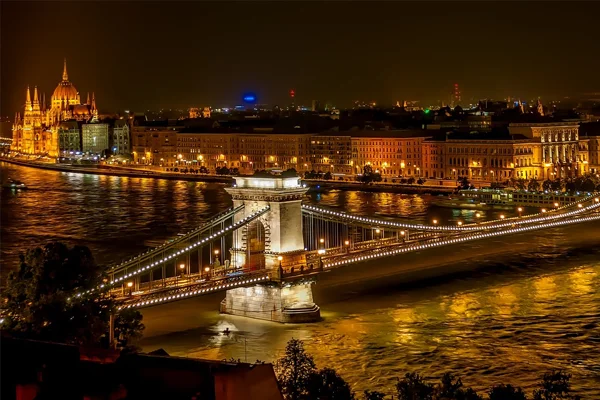Hungary has much to offer
The country, the personalities and lots of interesting facts.

Hungary is no longer a large country. It is also no longer a particularly important country and many people only know the country from a time after the fall of the Iron Curtain. But anyone who knows anything about history knows that this was not always the case. Hungary was once a great monarchy with far-reaching influence in Europe and without Hungary, Europe would probably look somewhat different today.
Stopping the Turkish armies on their way to Europe, its role alongside Austria in the First World War or the 1956 uprising against the Soviet occupation - Hungary has a firm place in history and played a major role in the creation of modern Europe.
Today, Hungary is a typical representative of the Europe that has expanded eastwards. A country on the move, with potential, with many opportunities but of course also with the associated difficulties and problems. A rich culture, Hungarian joie de vivre and marvellous landscapes contrast with low wages, high national debt and a devalued currency.
On these pages we would like to tell you why a visit to Hungary is always worthwhile and what makes this country so special.
Hungary in numbers and facts
- Population: ca. 10 Mio.
- Area: 93.000 m2
- Capital: Budapest
- Vehicle licence plate: H
- Timezone: Central European Summer Time (CET)
- Currency: Forint (FT)
- Average wage (2024): ca. $1184 (Source: ChatGPT)
Places of interest in Hungary - Places you have to see in Budapest and Hungary
Budapest (Capital City)
- Hungarian Parliament Building – Iconic riverside building with Gothic Revival architecture
- Buda Castle – Historic palace complex of the Hungarian kings
- Fisherman’s Bastion – Fairytale-like terrace with panoramic views of the Danube
- Matthias Church – Beautiful church with colorful Zsolnay roof tiles
- Chain Bridge – The oldest suspension bridge across the Danube in Hungary
- Heroes’ Square – Monumental square with statues of Hungary’s most important leaders
- St. Stephen’s Basilica – A neoclassical church with a panoramic dome view
- Andrássy Avenue – Elegant boulevard lined with mansions, shops, and the Opera House
- House of Terror Museum – Exhibition on 20th-century totalitarian regimes
- Széchenyi Thermal Bath – One of Europe’s largest spa complexes
- Gellért Hill & Citadel – Scenic lookout with Liberty Statue
- Vajdahunyad Castle – Eclectic castle in City Park
- Hungarian State Opera House – Lavish venue for opera and classical music
- Ruin Bars in the Jewish Quarter – Unique nightlife experience
- Great Market Hall – Vibrant indoor market offering local goods
Natural Wonders & Parks
- Lake Balaton – Largest freshwater lake in Central Europe, ideal for summer vacations
- Tihany Peninsula – Lavender fields, abbey, and stunning views over Balaton
- Hévíz Thermal Lake – Largest biologically active natural thermal lake in the world
- Hortobágy National Park – UNESCO site, Hungary’s “Puszta” (Great Plain) with native animals
- Aggtelek National Park – UNESCO-listed karst cave system including Baradla Cave
- Bükk National Park – Forests, caves, and wildlife in northeastern Hungary
- Kékes Mountain – Highest peak in Hungary with hiking and winter sports
- Danube Bend – Scenic curve of the Danube with historic towns like Visegrád and Esztergom
- Rába River and Őrség National Park – Unspoiled nature and folk villages in western Hungary
Castles & Historical Sites
- Eger Castle – Famous for its resistance against the Ottomans in 1552
- Visegrád Citadel – Medieval fortress overlooking the Danube
- Esztergom Basilica – Hungary’s largest church and seat of the Catholic Church
- Boldogkő Castle – Dramatic hilltop ruins in northern Hungary
- Sárospatak Castle – Renaissance castle with a rich history
- Szigliget Castle – Overlooking Lake Balaton
- Diósgyőr Castle – Gothic castle in Miskolc
- Gyula Castle – One of the few intact brick Gothic castles in Central Europe
Towns & Cities of Cultural Interest
- Eger – Baroque town known for its castle, wine (Egri Bikavér), and thermal baths
- Pécs – Cultural city with early Christian tombs (UNESCO), mosques, and Zsolnay ceramics
- Szeged – Known as the “City of Sunshine,” with Art Nouveau architecture and open-air theatre
- Debrecen – Hungary’s second-largest city and center of Calvinist culture
- Kőszeg – Charming town with medieval charm on the Austrian border
- Szentendre – Artist village near Budapest with cobbled streets and colorful buildings
- Győr – Baroque city at the confluence of three rivers
- Vác – Quaint riverside town with baroque churches and cafes
- Veszprém – One of Hungary’s oldest cities, known as the "City of Queens," with a charming old town, castle district, and vibrant cultural scene
Museums & Art
- Hungarian National Museum (Budapest)
- Museum of Fine Arts (Budapest)
- Ludwig Museum of Contemporary Art (Budapest)
- Open-Air Ethnographic Museum (Szentendre)
- Zsolnay Cultural Quarter (Pécs)
- Ferenc Liszt Memorial Museum (Budapest)
- Hungarian Natural History Museum
Wine Regions & Villages
- Tokaj Wine Region – UNESCO World Heritage, home of the famous Tokaji Aszú wine
- Villány – Renowned red wine region in southern Hungary
- Eger – Famous for Bull’s Blood (Egri Bikavér)
- Badacsony – White wines and volcanic hills on Lake Balaton’s northern shore
- Sopron – Historic wine-growing area in western Hungary
- Csopak–Balatonfüred Wine Region – Celebrated for its crisp Olaszrizling wines, terraced vineyards, and scenic views over the northern shore of Lake Balaton



